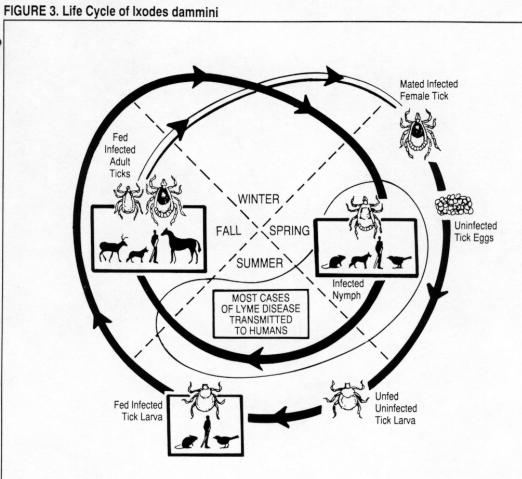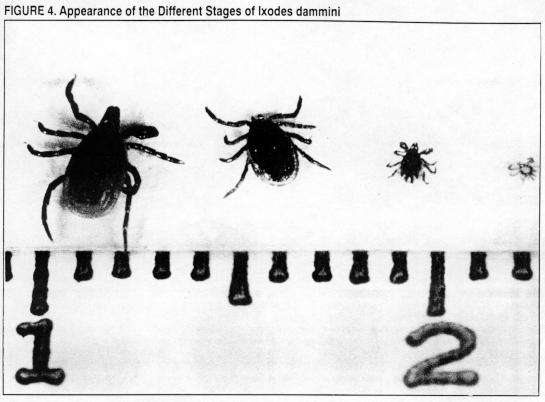Nature Class - March 1997
(Page 1)
The following
article was distributed to the Nature class at the Tracker School (March 1997)
by Jim Brown (Tom Brown's brother) who gave a talk on "Pathogens from the
woods, with a focus on New Jersey".
This article was
apparently written for medical personnel in New Jersey.
I don't know who wrote it.
Latin names used in the
article:
Deer-Mouse-Tick Connection
Ixodes dammini (previously thought to be a separate species known as I.
dammini) is the tick which spreads LD in New Jersey. It is also known as the deer tick, since it spends its adult stage feeding on white tailed deer. We now know that other medium and large-sized mammals can be just as hospitable as hosts to the tick. In the fall the female drops off to lay an egg mass, which is deposited under the layer of leaves and debris on the floor of the forest. The reason for this? The tick's egg mass can easily dehydrate, just as the adult and immature forms of tick can easily dehydrate. Thus, it is unlikely that the egg mass would be laid in a tree;
every December we get telephone inquiries from people asking if they can get LD from their Christmas tree. No, tick eggs are not found in trees and ticks are not found in Christmas trees.
Tick eggs hatch in the spring usually without the disease organism. Experimental evidence suggests that the organism may alter the tick egg and render it less viable. Probably less than 1% of ticks are born infected, so that when the first immature form of tick, the larva, emerges from its egg in the spring, it usually does not carry the organism. The larva then tries to find a blood meal. Ticks depend upon a single blood meal for their nutrition and fluid intake, during each stage of development: arthropods which take in blood as meals are termed hematophagous, which simply means "eating blood". Pre-adult stages of Ixodid ticks in the Northeast most often obtain their blood meal from white-footed mice, found throughout the state. The only way you may be aware that these small rodents are on your property is if your cat brings one to you as an offering. In any event, a single mouse can support hundreds of these tiny ticks, about the size of a poppy seed, at a time. Larvae will feed on the mouse for quite a while and after finishing their meal will drop off and undergo metamorphosis, the following spring, into the next tick stage, called the nymph. During the process of getting a blood meal, an uninfected larva may acquire
B. burgdoferi if the source of the blood meal happened to be an infected animal. Although the white-footed mouse is the principal maintenance host (source of the blood meal) and reservoir host (source of the infection), deer tick are not host-specific and feed on a variety of animals.
The nymph is somewhat larger, about the size of a sesame seed. Even though it is larger. the nymph is also easy to miss. Most nymphs get their next blood meal from another mouse, but the nymph may obtain sustenance from many other animals, as well. The nymph is also found in the leaf litter of wooded areas and waits for an animal to happen by. This can be a mouse, or a fox, or a bird, or a dog, or a human. Three points to appreciate here are that the tick does not jump or hop or fly (it has no wings) - it simply sits and waits for something that exhales carbon dioxide and is warm to walk by. The second is that an infected tick can hitch a ride on a bird or other animal, which may be the explanation for the spread of LD. Some investigators think that the steady spread of LD down the Atlantic coast may be explained by migrating birds picking up infected ticks in the autumn, with distribution to the Southeast as the birds make their way down the Atlantic flyway. All endemic regions of the United States are under main flyways. The third point is that an infected nymph can obtain its blood meal from a non-infected mouse in the spring or summer. This can then result in transmission of the infection to this previously naive mouse. Mice do not become sick with LD. Rather, they serve as a reservoir for the organism: they harbor large numbers of circulating organisms which can then be passed on to other hematophagous insects. Thus, the fact that the nymph can transmit the organism in the spring and summer, just in time to be in place for the next generation of larvae, is probably one of the reasons that LD becomes endemic in new areas so quickly.
Once the nymph has been on board its host for a day or two, it takes its blood meal and leaves the mouse to undergo metamorphosis again, emerging as a male or female adult in the fall. The adults utilize a variety of medium to large mammalian hosts, including deer, to act as host, and then the two year life cycle of
Ixodes dammini is repeated; this lifecycle is depicted in Figure 3
(below). Figure 4 shows the various stages of the tick and gives a sense of the size and coloration of the
tick (below).

The next photo shows the various life stages of the Deer
tick above a one-inch scale

There can be little argument that I. dammini nymphs are responsible for 70 to 80% of transmission of LD. Since nymphs are not present between October and March, cases with dates of onset between October and March can only be the result of exposure to adult deer ticks. In fact, adults ticks normally have a rate of infection twice that of nymphs (50% and 25%, respectively) in endemic areas. The reason we do not see more cases from October to March are:
- There are fewer adults than nymphs
- Adults are considerably larger than nymphs and are more easily observed and removed before they have a chance to feed (and transmit the spirochete)
- Fewer people are in deer tick habitats in the late fall, winter, and early spring
- People who are in deer tick habitats during these colder months generally wear multiple layers of clothing, thereby reducing the opportunity for deer ticks to feed.
Page 1 Page
2 |